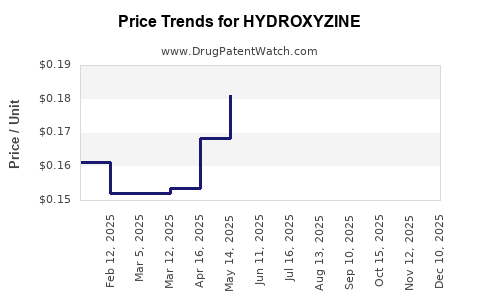Drug Price Trends for HYDROXYZINE
✉ Email this page to a colleague

Average Pharmacy Cost for HYDROXYZINE
| Drug Name | NDC | Price/Unit ($) | Unit | Date |
|---|---|---|---|---|
| HYDROXYZINE 10 MG/5 ML SOLN | 83745-0232-16 | 0.16644 | ML | 2024-11-20 |
| HYDROXYZINE PAM 25 MG CAP | 68084-0847-11 | 0.05412 | EACH | 2024-11-20 |
| HYDROXYZINE PAM 25 MG CAP | 68084-0847-01 | 0.05412 | EACH | 2024-11-20 |
| >Drug Name | >NDC | >Price/Unit ($) | >Unit | >Date |
Best Wholesale Price for HYDROXYZINE
| Drug Name | Vendor | NDC | Count | Price ($) | Price/Unit ($) | Unit | Dates | Price Type |
|---|---|---|---|---|---|---|---|---|
| HYDROXYZINE HCL 25MG TAB | AvKare, LLC | 23155-0501-10 | 1000 | 51.28 | 0.05128 | EACH | 2023-06-15 - 2028-06-14 | FSS |
| HYDROXYZINE HCL 50MG TAB | AvKare, LLC | 23155-0502-10 | 1000 | 75.15 | 0.07515 | EACH | 2023-06-15 - 2028-06-14 | FSS |
| HYDROXYZINE HCL 10MG TAB | AvKare, LLC | 00093-5060-05 | 500 | 29.98 | 0.05996 | EACH | 2023-06-15 - 2028-06-14 | FSS |
| >Drug Name | >Vendor | >NDC | >Count | >Price ($) | >Price/Unit ($) | >Unit | >Dates | >Price Type |


